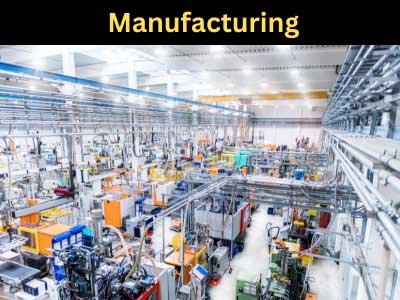Key Takeaway
Additive manufacturing, or 3D printing, is used across multiple industries. In aerospace, it creates lightweight, strong components, reducing fuel consumption and enhancing performance. In the automotive sector, it’s used for prototyping and producing custom parts, speeding up development.
Healthcare uses additive manufacturing to produce custom implants and prosthetics tailored to individual patients. The consumer goods industry also benefits from 3D printing for customized products and rapid prototyping. These examples show how additive manufacturing enhances production and innovation across various sectors.
Aerospace Industry: Pioneering Additive Applications
The aerospace industry has been a leader in adopting additive manufacturing due to its ability to create lightweight, high-performance parts. Reducing component weight directly improves fuel efficiency and aircraft performance. Additive manufacturing enables engineers to design complex structures, such as internal lattices, that reduce weight while maintaining strength.
For example, GE Aviation uses 3D printing to produce fuel nozzles that are 25% lighter and five times more durable than traditional versions. Additive manufacturing also streamlines production by consolidating multiple parts into a single printed component.
This technology’s flexibility and precision make it ideal for producing custom parts and prototypes. As aerospace continues to focus on lightweight, durable designs, additive manufacturing will remain a vital tool for innovation.

Automotive Industry: Custom Parts and Prototyping
The automotive industry has also embraced additive manufacturing, particularly in the areas of prototyping and customization. Traditional manufacturing methods in the automotive sector require tooling and molds, which can be expensive and time-consuming. Additive manufacturing eliminates these barriers by allowing engineers to quickly produce prototypes directly from digital models, speeding up the development cycle.
Companies like Ford and BMW use 3D printing to develop custom parts, such as lightweight interior panels or specialized components for high-performance vehicles. This capability is especially useful in motorsports, where teams can rapidly iterate on designs to optimize performance. In some cases, additive manufacturing allows for the production of complex, functional parts that would be impossible or too costly to produce using traditional methods.
Additionally, additive manufacturing enables mass customization in the automotive industry. Car manufacturers can offer customized features or limited-edition designs by printing parts on demand, rather than committing to large-scale production runs. This ability to personalize vehicles not only enhances the customer experience but also reduces waste and excess inventory.
Healthcare: Revolutionizing Medical Device Manufacturing
Few industries have benefited as significantly from additive manufacturing as healthcare. The ability to produce custom, patient-specific devices has revolutionized the medical field, where one-size-fits-all solutions often fall short. Additive manufacturing allows for the creation of custom prosthetics, implants, and surgical tools tailored to an individual’s exact anatomy.
For example, 3D-printed implants can be custom-fitted to a patient’s unique bone structure, improving surgical outcomes and reducing recovery time. This technology is also used to create biocompatible materials, such as dental crowns, hearing aids, and even bio-printed tissues for medical research. In prosthetics, additive manufacturing enables the creation of lightweight, durable, and affordable solutions for individuals who need custom-fit limbs.
The healthcare industry is also using additive manufacturing for pre-surgical planning. Surgeons can print 3D models of patients’ organs or bones to study complex cases before performing the actual surgery, enhancing precision and improving patient care. As materials and technologies continue to advance, the possibilities for innovation in healthcare through additive manufacturing are boundless.
Consumer Goods: Customization and Personalization
The consumer goods industry is increasingly leveraging additive manufacturing to meet the demand for customization and personalization. Whether it’s fashion, home décor, or electronics, consumers are seeking unique products that reflect their personal tastes. Additive manufacturing enables companies to produce small-batch, custom designs without the need for mass production infrastructure.
For example, companies like Nike and Adidas are using 3D printing to create custom footwear that is tailored to an individual’s foot shape and activity needs. These shoes offer enhanced comfort, performance, and fit. Similarly, jewelry designers are using additive manufacturing to create intricate, one-of-a-kind pieces that would be impossible or too costly to produce using traditional methods.
In the electronics sector, 3D printing is being used to produce custom phone cases, accessories, and even specialized components for wearable technology. The ability to create personalized products quickly and affordably is transforming how companies approach consumer-driven design and manufacturing.
Construction: Additive Manufacturing in Building Design
The construction industry is also exploring the potential of additive manufacturing, particularly in the area of 3D-printed buildings and architectural components. Using large-scale 3D printers, companies are able to print entire structures, layer by layer, using concrete, metal, or composite materials. This technology not only reduces construction waste but also enables the design of complex, customized building elements that would be difficult or costly to achieve with traditional methods.
For example, 3D-printed homes have been built in regions facing housing shortages or natural disasters, offering a fast and cost-effective solution. The technology can significantly reduce construction time, with some homes being printed in just 24 hours. Additionally, additive manufacturing allows architects to design structures with unique geometries and organic shapes, pushing the boundaries of traditional building design.
Additive manufacturing is also being used to create customized building components, such as decorative facades, modular walls, and even structural elements like beams and columns. As 3D printing technology continues to advance, it’s likely that the construction industry will see more sustainable, efficient, and innovative building solutions.
Conclusion
From aerospace and automotive to healthcare and consumer goods, additive manufacturing is transforming how industries design and produce parts, offering unprecedented levels of customization, efficiency, and innovation. Its ability to produce complex geometries, reduce waste, and enable rapid prototyping makes it an invaluable tool across sectors.
As a new engineer, understanding how different industries leverage additive manufacturing will give you insight into the wide-ranging potential of this technology. Whether it’s creating custom medical implants, lightweight aerospace components, or personalized consumer products, additive manufacturing is driving the future of modern production and enabling industries to push the boundaries of design and performance.
